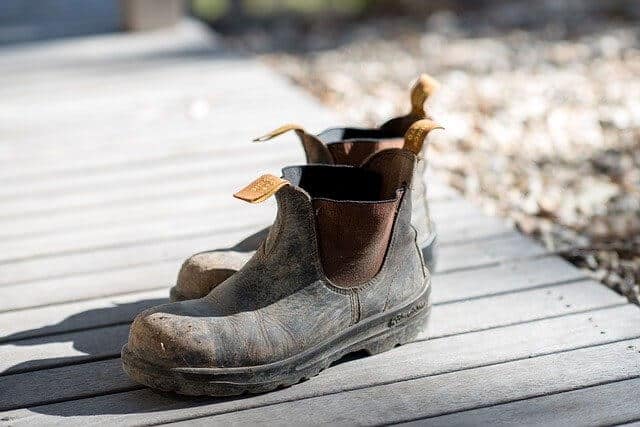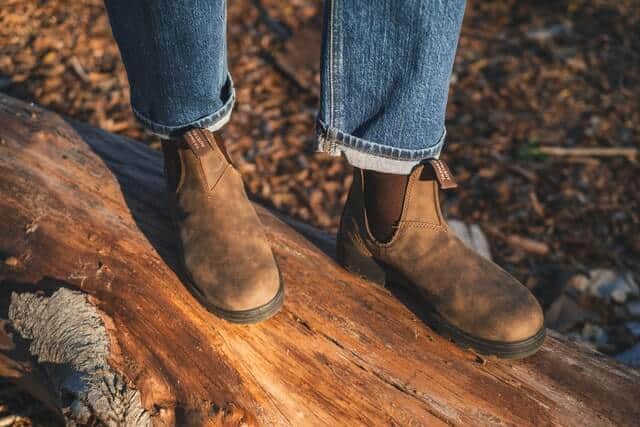Blundstones are shoes that can be found in many different styles and colors. They are made with leather or synthetic materials, but the reason they last so long is because of how waterproof they are.
It’s easy to see why these shoes would make great outdoor work boots. But what if you want to make your Blundstone just a little bit more water-resistant?
This blog post will teach you all about waterproofing Blundstones, from start to finish.
Waterproofing Blundstones Guide
1. Remove the Laces From Your Shoes
This will make it a lot easier for you to take apart your shoes and put them back together when you’re done waterproofing them. If you skip this step, you might end up breaking some of the glue that holds different parts of your shoe together.
I’m going to be using a pair of boots as well as a pair of work boots as examples throughout this blog post. But usually, all Blundstones follow the same pattern in terms of how they are made.
2. Apply Water-Resistant Protector
You should use a brand of shoe polish that is made of wax and cream polish, as well as water-resistant protectors. It is advisable to use shoe polish that is cream in color.
This color will suit most leathers very well because it has a natural-looking hue to it, without being too dark or light. Cream polishes last a lot longer than wax polishes do, but they can be a bit more difficult to work with on your shoes.
Wax polishes are much easier to apply and often dry faster than cream polishes do, which means you won’t have to wait as long for it to dry before you put your Blundstones back together.
However, applying wax polishes does mean that you need to wait for the wax to completely dry and harden before you can brush it off, or else it will just smear all over your shoes.
3. Let the Material Dry
You want to make sure you don’t use too much of the water-resistant protector on any part of your shoe, or else you might end up waterproofing some parts that didn’t need it and couldn’t handle the extra weight.
But if you want to make sure you’ve gone over every single crevice and seam with a protective layer, then go ahead and do that. You can also use a very fine brush or even an old toothbrush as long as they’re not too coarse.
I usually let everything dry overnight before I take a look at the finished product. If you’ve applied enough protector and used a brush with soft bristles to apply it, then there should be no smearing or streaks on your shoes (unless you missed some spots, of course).
But like I said earlier if your shoes are already waterproofed but just need some extra water resistance where they’re not as protected (in case of heavy rainfall), then all you have to do is use wax instead of the cream polish that I’d originally suggested.
Using this method will make your Blundstones even lighter than usual. So for this part, you just want to use the wax polish and a stiff brush and go over all your shoes in circular motions until you’re satisfied with how they look.
4. Put The Blundstones Back Together
Now that we’ve finished applying the water-resistant protector, it’s time to put our laces back in. You can use any kind of laces you like, but if your Blundstones don’t already have round eyelets then I suggest using round leather shoelaces instead.
This will help avoid having weird creases when you tie up your boots.
Things to Avoid When Waterproofing Your Blundstones
Don’t use silicone sprays. These will make your Blundstones water-resistant, but they don’t actually “seep” into the fabric of the shoe and provide better protection. – If you’re wearing your boots in extremely cold weather, then it’s best not to waterproof them with protectors that are meant for very hot climates. This is because when you have warm/hot protectors on a pair of boots that are worn outside in below 40-degree weather, then that could cause the soles of your shoe to split apart.
Don’t spray your shoes with anything if they already have mesh vents built into the sides. Those mesh vents are there so you can let some air flow through your shoes during warmer days or times when your feet might be sweaty. If you spray your shoes directly onto the mesh vents, then this will close them up and cause your boots to build up heat inside instead of letting anything out.
Don’t use wax protectors on leather or suede shoes because they can seep into the fabric and make them look shiny (which is very bad if you want to preserve the natural texture of your shoe). You should only use cream polishes on smooth leathers or suedes, which are meant for lighter protection. – Don’t go over the same area too many times with either method (wax or cream) because that can also cause smearing.
When buying a water-resistant polish, make sure it’s made for shoes and not clothes. If the product is meant to be used on clothing, then it simply won’t work as well as a shoe protector.
If you’re having difficulty polishing or applying any kind of cream or wax treatment to your boots because they have so many creases and seams around the soles, then just try to focus on going over those areas more rather than all over your shoes.
Final Thoughts
Waterproofing your Blundstones is super easy and you should do it to protect your investment. These shoes might not be too expensive, but they’re still made of real leather which will wear out over time if you don’t take care of them.
Additionally, it can prolong the life of your shoe if you’re wearing them in colder seasons when it’s raining out because water-resistant protectors will help keep heat in and also won’t let any water soak into the leather itself (which would make them crack much faster).



